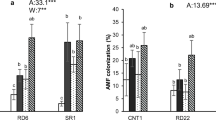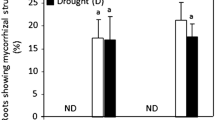Abstract
Drought is a major abiotic factor limiting agricultural crop production. One of the effective ways to increase drought resistance in plants could be to optimize the exploitation of symbiosis with arbuscular mycorrhizal fungi (AMF). Hypothesizing that alleviation of water deficits by AMF in wheat will help maintain photosynthetic carbon-use, we studied the role of AMF on gas-exchange, light-use efficiencies, carbon/nitrogen ratios and growth and yield parameters in the contrasting wheat (Triticum aestivum L.) cultivars ‘Vinjett’ and ‘1110’ grown with/without AMF symbiosis. Water deficits applied at the floret initiation stage significantly decreased rates of photosynthetic carbon gain, transpiration and stomatal conductance in the two wheat cultivars. AMF increased the rates of photosynthesis, transpiration and stomatal conductance under drought conditions. Water deficits decreased electron transport rate and increased non-photochemical quenching (NPQ) in ‘1110’ but not in ‘Vinjett’. With AMF, nitrogen concentrations increased in roots of both cultivars, but decreased in grains of ‘Vinjett’ and in side-tiller grains of ‘1110’ regardless of water status. With water deficits, AMF colonization increased plant height in both cultivars. AMF also increased biomass and grain yield in ‘1110’ but not in ‘Vinjett’. The results showed that the improvements in growth and yield were the results of AMF-mediated increases in photosynthesis during drought stress and that the alleviating effect of AMF depended on the wheat cultivar.


Similar content being viewed by others
Abbreviations
- AMF:
-
Arbuscular mycorrhizal fungi
- C:
-
Total carbon content
- N:
-
Total nitrogen content
- SRWC:
-
Soil relative water content
- FW:
-
Fresh weight
- DW:
-
Dry weight
- MT:
-
Main tiller
- ST:
-
Side tillers
- A:
-
Photosynthesis rate
- gs:
-
Stomatal conductance
- E:
-
Transpiration rate
- ΦPSII :
-
Effective quantum yield of photosystem II
- ETR:
-
Electron transfer rate to photosystem II
- NPQ:
-
Non-photochemical quenching
- SE:
-
Standard error
References
Al-Karaki G, McMichael B, Zak J (2004) Field response of wheat to arbuscular mycorrhizal fungi and drought stress. Mycorrhiza 14(4):263–269. doi:10.1007/s00572-003-0265-2
Altenbach SB (2012) New insights into the effects of high temperature, drought and post-anthesis fertilizer on wheat grain development. J Cereal Sci 56(1):39–50. doi:10.1016/j.jcs.2011.12.012
Augé RM (2001) Water relations, drought and vesicular-arbuscular mycorrhizal symbiosis. Mycorrhiza 11(1):3–42. doi:10.1007/s005720100097
Bänziger M (2000) Breeding for drought and nitrogen stress tolerance in maize: from theory to practice. Mexico, DF (Mexico) CIMMYT
Birhane E, Sterck F, Fetene M, Bongers F, Kuyper T (2012) Arbuscular mycorrhizal fungi enhance photosynthesis, water use efficiency, and growth of frankincense seedlings under pulsed water availability conditions. Oecologia 169(4):895–904. doi:10.1007/s00442-012-2258-3
Boomsma CR, Vyn TJ (2008) Maize drought tolerance: potential improvements through arbuscular mycorrhizal symbiosis? Field Crops Res 108(1):14–31. doi:10.1016/j.fcr.2008.03.002
Bruce WB, Edmeades GO, Barker TC (2002) Molecular and physiological approaches to maize improvement for drought tolerance. J Exp Bot 53(366):13–25
Bryla D, Eissenstat D (2005) Respiratory costs of mycorrhizal associations. In: Lambers H, Ribas-Carbo M (eds) plant respiration, vol 18. Advances in photosynthesis and respiration. Springer, The Netherlands, pp 207–224. doi:10.1007/1-4020-3589-6_12
Calatayud Á, Gorbe E, Roca D, Martínez PF (2008) Effect of two nutrient solution temperatures on nitrate uptake, nitrate reductase activity, NH4 + concentration and chlorophyll a fluorescence in rose plants. Environ Exp Bot 64(1):65–74
Chen X, Tu C, Burton MG, Watson DM, Burkey KO, Hu SJ (2007) Plant nitrogen acquisition and interactions under elevated carbon dioxide: impact of endophytes and mycorrhizae. Glob Change Biol 13(6):1238–1249. doi:10.1111/j.1365-2486.2007.01347.x
Demmig-Adams B, Adams WW (1996) The role of xanthophyll cycle carotenoids in the protection of photosynthesis. Trends Plant Sci 1(1):21–26
Duan XG, Neuman DS, Reiber JM, Green CD, Saxton AM, Auge RM (1996) Mycorrhizal influence on hydraulic and hormonal factors implicated in the control of stomatal conductance during drought. J Exp Bot 47(303):1541–1550. doi:10.1093/jxb/47.10.1541
Edmeades GO, Bolanos J, Chapman SC, Lafitte HR, Banziger M (1999) Selection improves drought tolerance in tropical maize populations. I. Gains in biomass, grain yield, and harvest index. Crop Sci 39:1306–1315
Erice G, Louahlia S, Irigoyen JJ, Sánchez-Díaz M, Alami IT, Avice J-C (2011) Water use efficiency, transpiration and net CO2 exchange of four alfalfa genotypes submitted to progressive drought and subsequent recovery. Environ Exp Bot 72(2):123–130. doi:10.1016/j.envexpbot.2011.02.013
Farzaneh M, Vierheilig H, Vienna, Loessl A, Kaul HP (2011) Arbuscular mycorrhiza enhances nutrient uptake in chickpea. Plant Soil Environ 57(10):465–470
Gholamhoseini M, Ghalavand A, Dolatabadian A, Jamshidi E, Khodaei-Joghan A (2013) Effects of arbuscular mycorrhizal inoculation on growth, yield, nutrient uptake and irrigation water productivity of sunflowers grown under drought stress. Agric Water Manag 117:106–114. doi:10.1016/j.agwat.2012.11.007
Giovannetti M, Mosse B (1980) An evaluation of techniques for measuring vesicular arbuscular mycorrhizal infection in roots. New Phytol 84(3):489–500. doi:10.1111/j.1469-8137.1980.tb04556.x
Goicoechea N, Merino S, Sánchez-Díaz M (2004) Contribution of arbuscular mycorrhizal fungi (AMF) to the adaptations exhibited by the deciduous shrub Anthyllis cytisoides L. under water deficit. Physiol Plant 122(4):453–464
Goicoechea N, Merino S, Sanchez-Diaz M (2005) Arbuscular mycorrhizal fungi can contribute to maintain antioxidant and carbon metabolism in nodules of Anthyllis cytisoides L. subjected to drought. J Plant Physiol 162(1):27–35. doi:10.1016/j.jplph.2004.03.011
Guidi L (2011) Imaging of chlorophyll a fluorescence: a tool to study abiotic stress in plants. Abiotic stress in plants-mechanisms and adaptations, In Tech Janeza Trdine, Rijeka, Croatia
IPCC (2007) Climate change 2007: impacts, adaptation and vulnerability working group II contribution to the intergovernmental panel on climate change. Fourth assessment report summary for policymakers, brussels
Jiang WS, Liu DH, Xu P (2009) Cd-induced system of defence in the garlic root meristematic cells. Biol Plant 53(2):369–372. doi:10.1007/s10535-009-0069-0
Jindal V, Atwal A, Sekhon BS, Singh R (1993) Effect of vesicular-arbuscular mycorrhizae on metabolism of moong plants under NaCl salinity. Plant Physiol Biochem 31(4):475–481
Jones DL, Clode PL, Kilburn MR, Stockdale EA, Murphy DV (2013) Competition between plant and bacterial cells at the microscale regulates the dynamics of nitrogen acquisition in wheat (Triticum aestivum). New Phytol 200(3):796–807. doi:10.1111/nph.12405
Kaya C, Higgs D, Kirnak H, Tas I (2003) Mycorrhizal colonisation improves fruit yield and water use efficiency in watermelon (Citrullus lanatus Thunb.) grown under well-watered and water-stressed conditions. Plant Soil 253(2):287–292. doi:10.1023/a:1024843419670
Khalvati MA, Hu Y, Mozafar A, Schmidhalter U (2005) Quantification of water uptake by arbuscular mycorrhizal hyphae and its significance for leaf growth, water relations, and gas exchange of barley subjected to drought stress. Plant Biol 7(6):706–712
Kitao M, Lei TT (2007) Circumvention of over-excitation of PSII by maintaining electron transport rate in leaves of four cotton genotypes developed under long-term drought. Plant Biol 9(1):69–76. doi:10.1055/s-2006-924280
Krasensky J, Jonak C (2012) Drought, salt, and temperature stress-induced metabolic rearrangements and regulatory networks. J Exp Bot 63(4):1593–1608. doi:10.1093/jxb/err460
Lee B-R, Muneer S, Avice J-C, Jung W-J, Kim T-H (2012) Mycorrhizal colonisation and P-supplement effects on N uptake and N assimilation in perennial ryegrass under well-watered and drought-stressed conditions. Mycorrhiza 22(7):525–534. doi:10.1007/s00572-012-0430-6
Li HY, Smith SE, Holloway RE, Zhu YG, Smith FA (2006) Arbuscular mycorrhizal fungi contribute to phosphorus uptake by wheat grown in a phosphorus-fixing soil even in the absence of positive growth responses. New Phytol 172(3):536–543. doi:10.1111/j.1469-8137.2006.01846.x
Li QM, Liu BB, Wu Y, Zou ZR (2008) Interactive effects of drought stresses and elevated CO2 concentration on photochemistry efficiency of cucumber seedlings. J Integr Plant Biol 50(10):1307–1317
Lichtenthaler HK, Ač A, Marek MV, Kalina J, Urban O (2007) Differences in pigment composition, photosynthetic rates and chlorophyll fluorescence images of sun and shade leaves of four tree species. Plant Physiol Biochem 45(8):577–588. doi:10.1016/j.plaphy.2007.04.006
Mäder P, Vierheilig H, Streitwolf-Engel R, Boller T, Frey B, Christie P, Wiemken A (2000) Transport of 15N from a soil compartment separated by a polytetrafluoroethylene membrane to plant roots via the hyphae of arbuscular mycorrhizal fungi. New Phytol 146(1):155–161. doi:10.1046/j.1469-8137.2000.00615.x
Massacci A, Nabiev SM, Pietrosanti L, Nematov SK, Chernikova TN, Thor K, Leipner J (2008) Response of the photosynthetic apparatus of cotton (Gossypium hirsutum) to the onset of drought stress under field conditions studied by gas-exchange analysis and chlorophyll fluorescence imaging. Plant Physiol Biochem 46(2):189–195. doi:10.1016/j.plaphy.2007.10.006
Mobasser HR, Moradgholi A, Mehraban A, Koohkan S (2012) Investigation of mycorrhizal effect on agronomic traits and protein percent of corn varieties in sistan. Int J Agric Sci 2(2):108–119
Owens H, LaFantasie J, Adler PB (2012) Mycorrhization rates of two grasses following alterations in moisture inputs in a southern mixed grass prairie. Appl Soil Ecol 60:56–60. doi:10.1016/j.apsoil.2012.03.003
Pozo MJ, Jung SC, Lopez-Raez JA, Azcon-Aguilar C (2010) Impact of arbuscular mycorrhizal symbiosis on plant response to biotic stress: the role of plant defence mechanisms. Physiology and function arbuscular mycorrhizas. doi:10.1007/978-90-481-9489-6_9
Ruiz-Lozano JM (2003) Arbuscular mycorrhizal symbiosis and alleviation of osmotic stress. New perspectives for molecular studies. Mycorrhiza 13(6):309–317. doi:10.1007/s00572-003-0237-6
Ruiz-Lozano JM, Azcón R (1996) Mycorrhizal colonization and drought stress as factors affecting nitrate reductase activity in lettuce plants. Agric Ecosyst Environ 60(2–3):175–181. doi:10.1016/S0167-8809(96)01074-2
Ruiz-Lozano JM, Gómez M, Azcón R (1995) Influence of different glomus species on the time-course of physiological plant responses of lettuce to progressive drought stress periods. Plant Sci 110(1):37–44. doi:10.1016/0168-9452(95)04184-V
Ruiz-Sanchez M, Armada E, Munoz Y, de Salamone IEG, Aroca R, Ruiz-Lozano JM, Azcon R (2011) Azospirillum and arbuscular mycorrhizal colonization enhance rice growth and physiological traits under well-watered and drought conditions. J Plant Physiol 168(10):1031–1037. doi:10.1016/j.jplph.2010.12.019
Schalamuk S, Cabello MN, Chidichimo H, Golik S (2011) Effects of inoculation with glomus mosseae in conventionally tilled and nontilled soils with different levels of nitrogen fertilization on wheat growth, arbuscular mycorrhizal colonization, and nitrogen nutrition. Commun Soil Sci Plant Anal 42(5):586–598. doi:10.1080/00103624.2011.546924
Sharma DK, Andersen SB, Ottosen C-O, Rosenqvist E (2012) Phenotyping of wheat cultivars for heat tolerance using chlorophyll a fluorescence. Funct Plant Biol 39(11):936. doi:10.1071/fp12100
Smith SE, Smith FA (2011) Roles of arbuscular mycorrhizas in plant nutrition and growth: new paradigms from cellular to ecosystem scales. In: merchant SS, Briggs WR, Ort D (eds). Annu Rev Plant Biol 62:227–250. doi:10.1146/annurev-arplant-042110-103846
Smithwick EAH, Eissenstat DM, Lovett GM, Bowden RD, Rustad LE, Driscoll CT (2013) Root stress and nitrogen deposition: consequences and research priorities. New Phytol 197(3):712–719. doi:10.1111/nph.12081
Subramanian KS, Charest C (1999) Acquisition of N by external hyphae of an arbuscular mycorrhizal fungus and its impact on physiological responses in maize under drought-stressed and well-watered conditions. Mycorrhiza 9(2):69–75. doi:10.1007/s005720050002
Tanaka Y, Yano K (2005) Nitrogen delivery to maize via mycorrhizal hyphae depends on the form of N supplied. Plant Cell Environ 28(10):1247–1254. doi:10.1111/j.1365-3040.2005.01360.x
Vandenkoornhuyse P, Mahé S, Ineson P, Staddon P, Ostle N, Cliquet J, Francez A, Fitter A, Young J (2007) Active root-inhabiting microbes identified by rapid incorporation of plant-derived carbon into RNA. PANS 104(43):16970–16975
Vierheilig H, Coughlan AP, Wyss U, Piche Y (1998) Ink and vinegar, a simple staining technique for arbuscular-mycorrhizal fungi. Appl Environ Microbiol 64(12):5004–5007
Wollenweber B, Porter JR, Lubberstedt T (2005) Need for multidisciplinary research towards a second green revolution—commentary. Curr Opin Plant Biol 8(3):337–341
Wu Q-S, Xia R-X (2006) Arbuscular mycorrhizal fungi influence growth, osmotic adjustment and photosynthesis of citrus under well-watered and water stress conditions. J Plant Physiol 163(4):417–425. doi:10.1016/j.jplph.2005.04.024
Yang F, Jorgensen AD, Li H, Sondergaard I, Finnie C, Svensson B, Jiang D, Wollenweber B, Jacobsen S (2011) Implications of high-temperature events and water deficits on protein profiles in wheat (Triticum aestivum L. cv. Vinjett) grain. Proteomics 11(9):1684–1695. doi:10.1002/pmic.201000654
Acknowledgments
We thank Betina Hansen and Ulla Andersen for their help in setting up the pot experiment at the Research Centre Flakkebjerg. We thank Anne-Pia Holde Larsen for her help in estimating AM fungal root colonization and Birgitte Kjærgaard for the C/N analysis of the plant samples. DANIDA has contributed to the stay of Qin Zhou in Denmark.
Conflict of interest
The authors declare no conflict of interest.
Author information
Authors and Affiliations
Corresponding author
Electronic supplementary material
Below is the link to the electronic supplementary material.

10725_2014_9977_MOESM1_ESM.jpg
Soil relative water content (SRWC) during the drought treatment. Vertical bars indicate standard error (n = 5) (JPEG 103 kb)

Rights and permissions
About this article
Cite this article
Zhou, Q., Ravnskov, S., Jiang, D. et al. Changes in carbon and nitrogen allocation, growth and grain yield induced by arbuscular mycorrhizal fungi in wheat (Triticum aestivum L.) subjected to a period of water deficit. Plant Growth Regul 75, 751–760 (2015). https://doi.org/10.1007/s10725-014-9977-x
Received:
Accepted:
Published:
Issue Date:
DOI: https://doi.org/10.1007/s10725-014-9977-x




